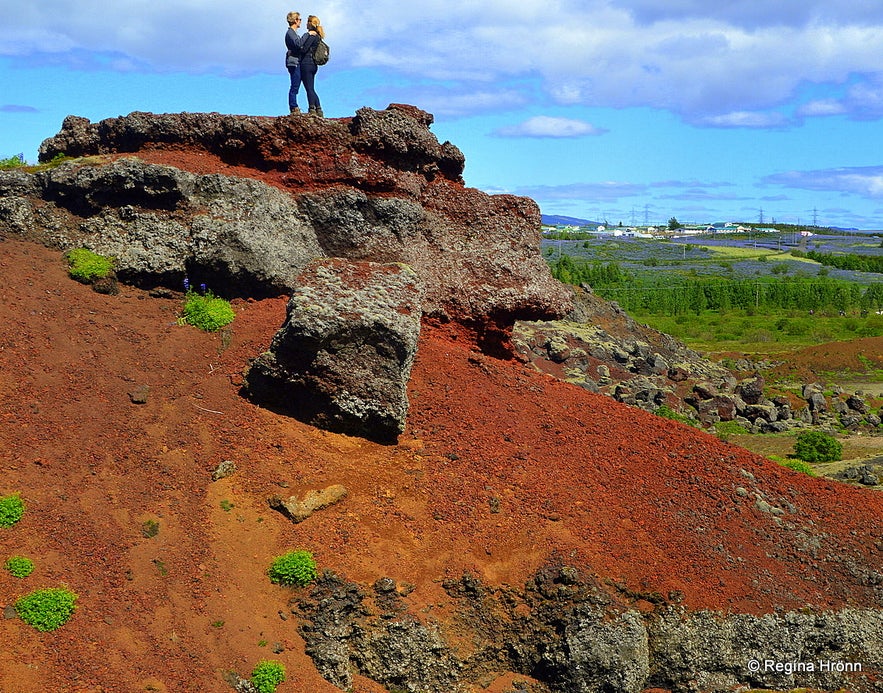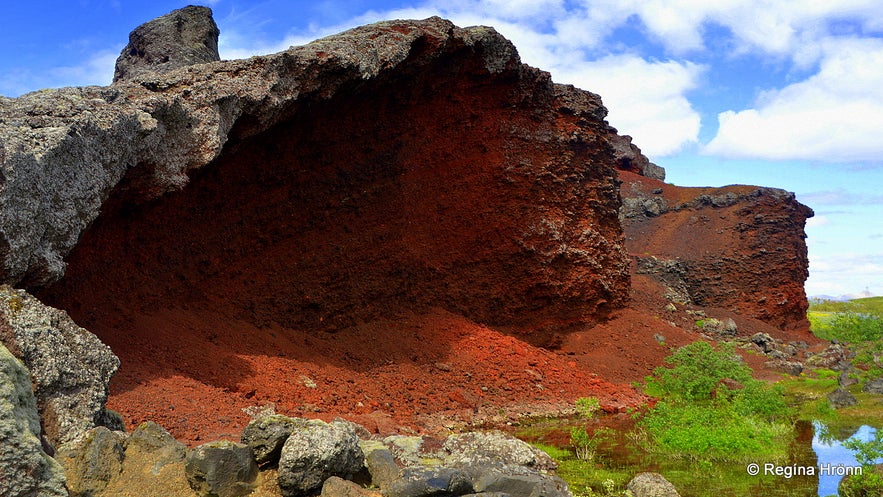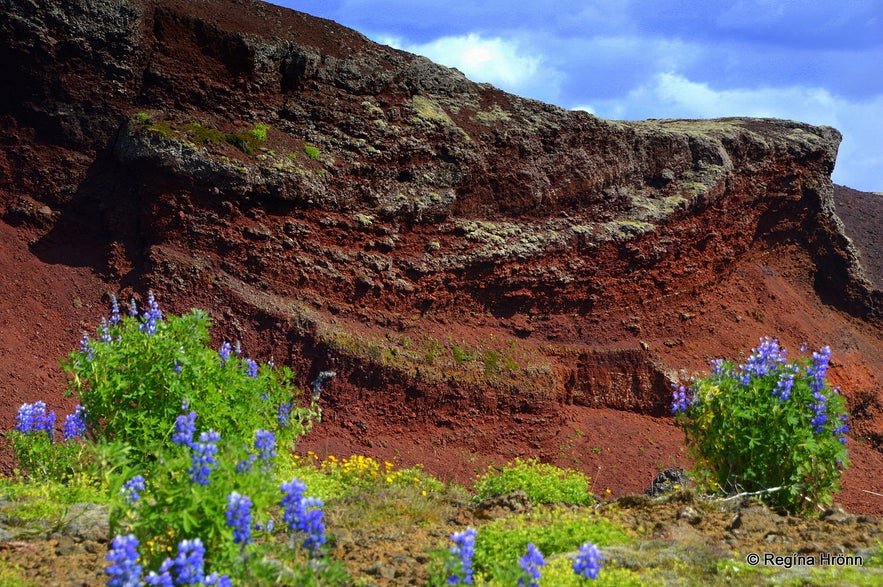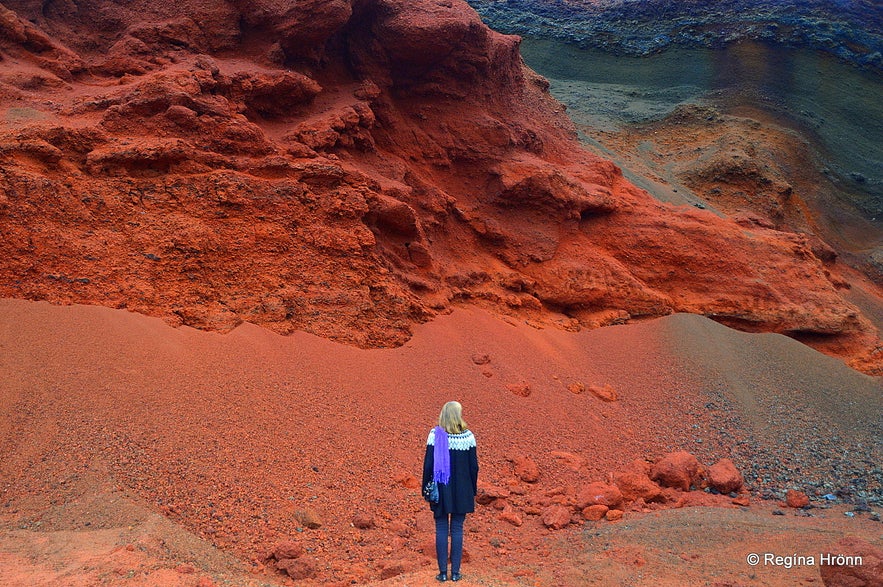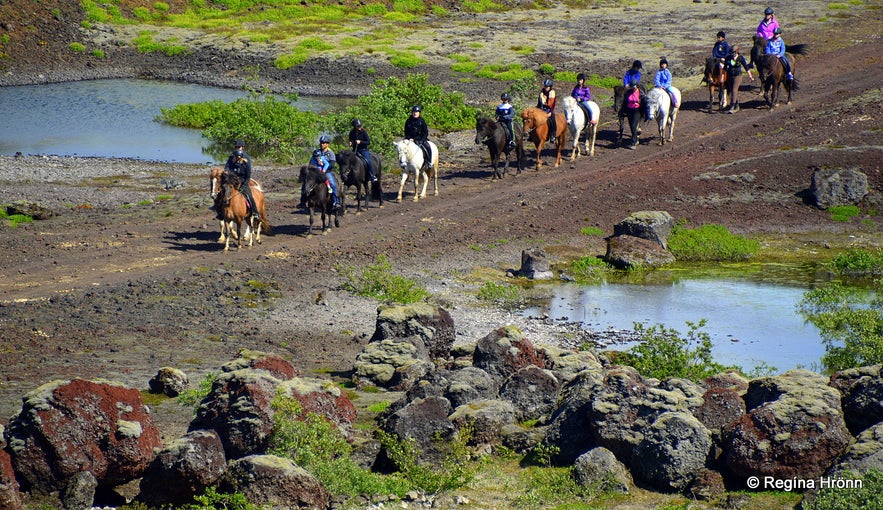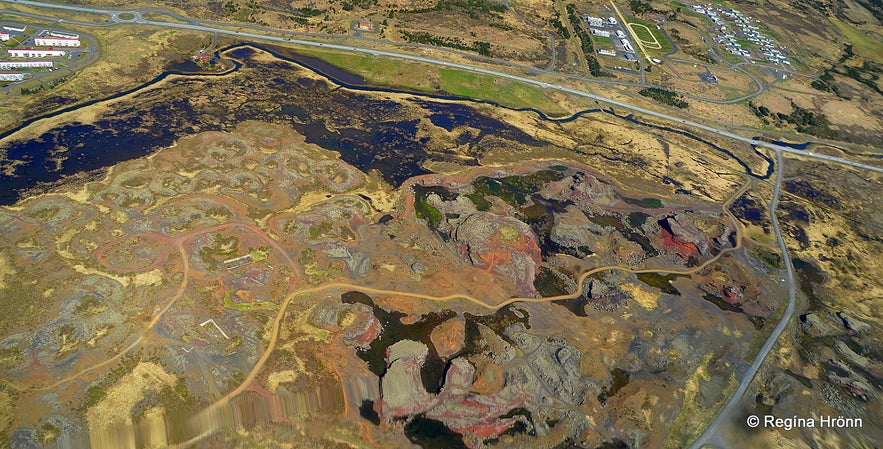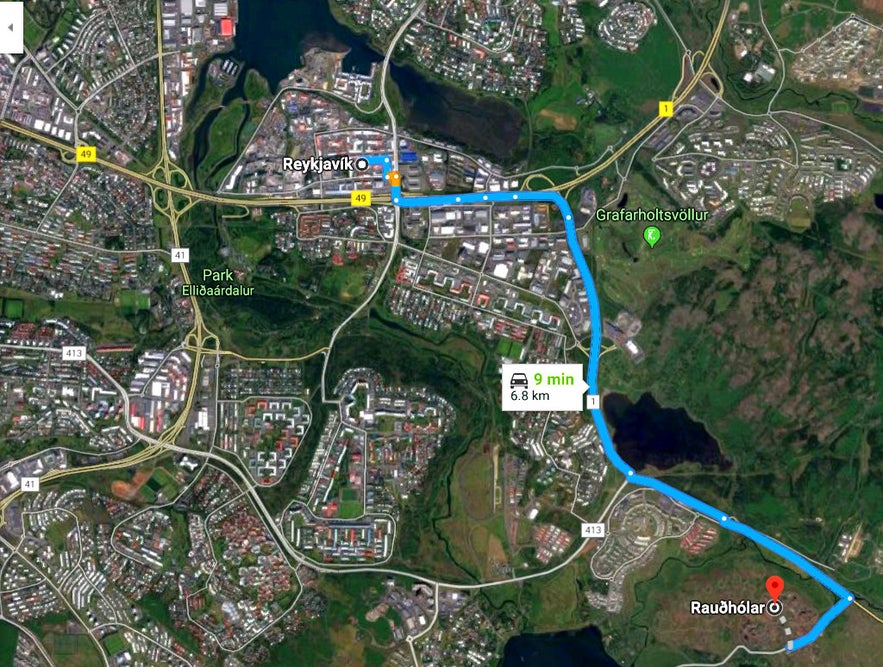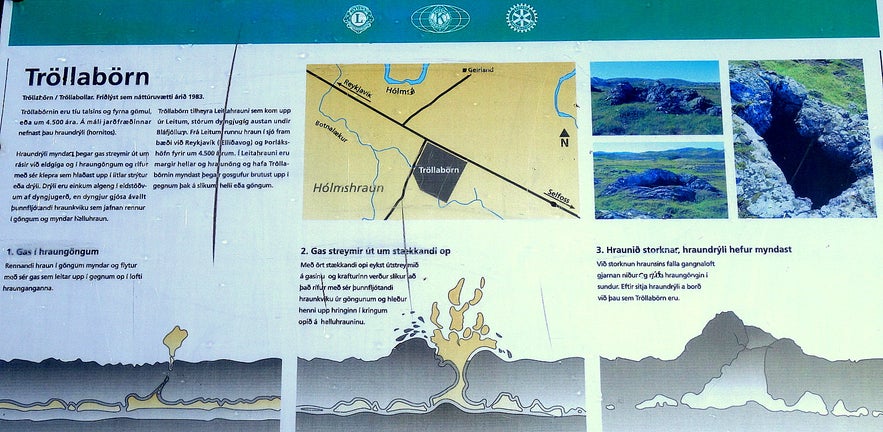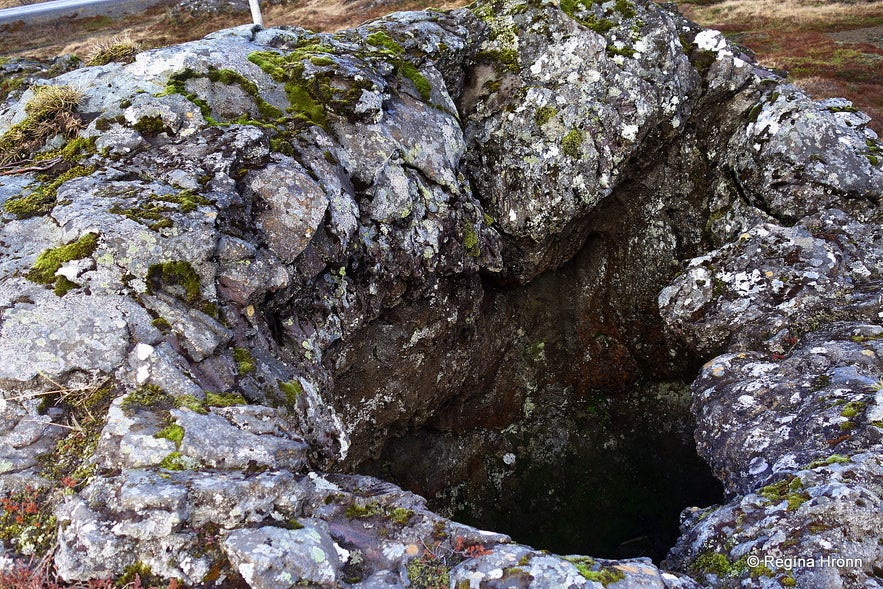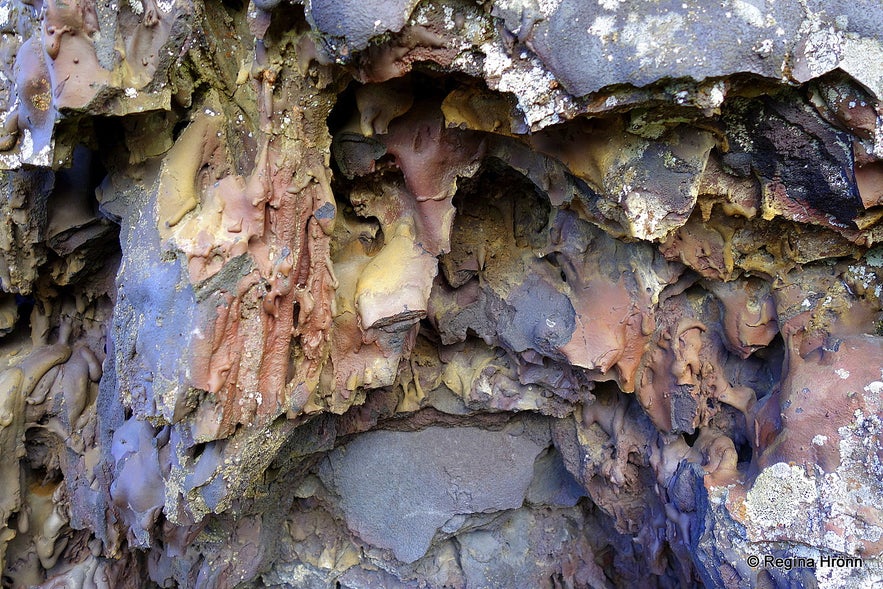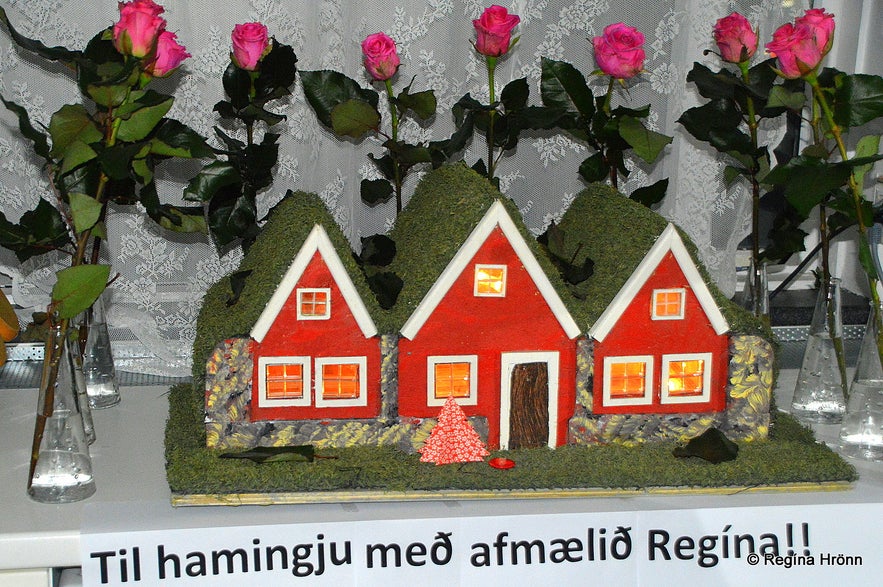
The mystical Rauðhólar Pseudocraters and Tröllabörn - the Troll Children in SW-Iceland

In this travel-blog I am going to show you a special phenomenon that you pass when you drive on ring-road 1 just east of Reykjavík city.
You will notice a cluster of dark maroon hills. These hills are called Rauðhólar - Red Hills and are around 5,000 years old pseudocraters - give or take a few years.
Top photo: a lovely couple on top of one of the pseudocraters
Rauðhólar pseudocraters
Pseudocraters are as far as I know rarely seen outside of Iceland and on the planet Mars, so they are quite an interesting phenomenon.
They are formed when 1,100°C molten lava flows over ponds and swamps causing the water to boil.
The pressure of the steam from the boiling water then causes explosions, which in turn creates the pseudocraters.
Rauðhólar pseudocraters
These prominent pseudocraters, Rauðhólar, are located in the Leitahraun lava field, which flowed in this area during an eruption from the shield volcano Leiti.
The part of the lava field by Rauðhólar is called the Elliðaárhraun lava field located in the Nature Reserve of Heiðmörk.
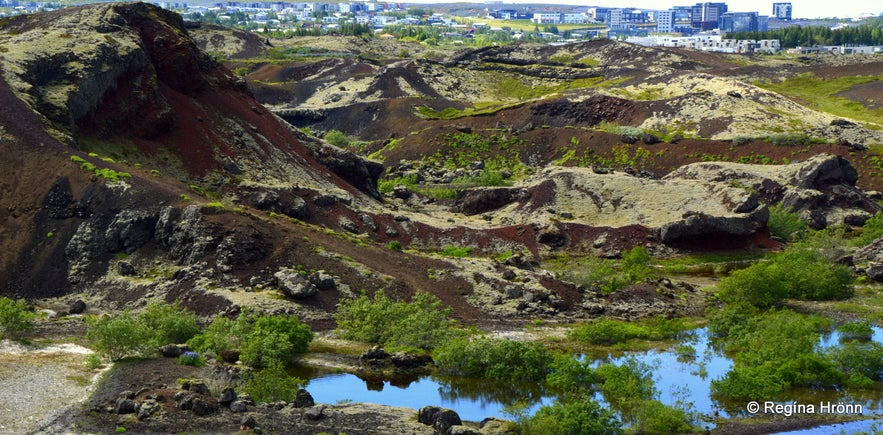
Rauðhólar - Reykjavík in the distance
What makes Rauðhólar pseudo craters so beautiful to me is that they are bright red in colour, which is caused by the scoria being coloured by the oxidation of the iron in the lava.
I have seen pseudocraters in several other places in Iceland, f.ex. the shapely Skútustaðagígar pseudocraters at Mývatn in North Iceland.
 Rauðhólar
Rauðhólar
And the Álftaver and Landbrotshólar pseudocraters in South Iceland.
The area of Landbrotshólar is actually the largest area of pseudocraters in Iceland, covering some 50 sq. km. I have written about them in my travel-blog:
The Elf-City and the amazing surroundings by Hotel Laki
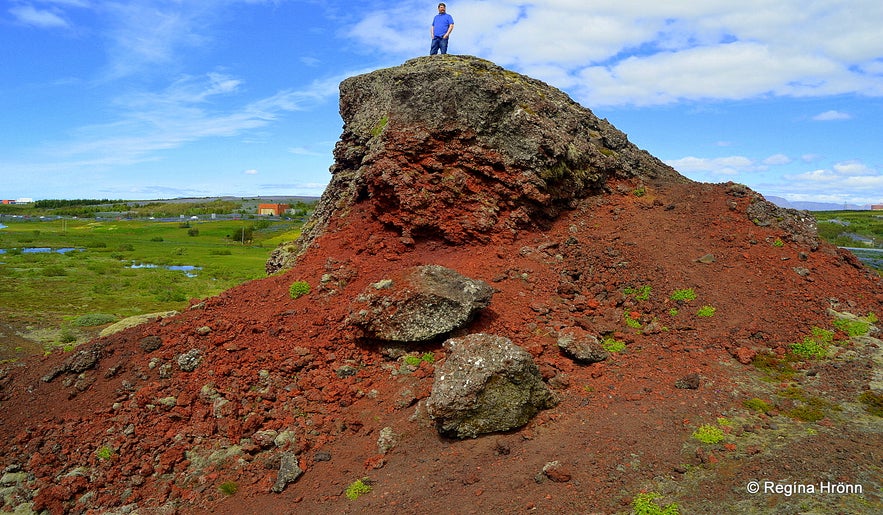
My husband on top of Rauðhólar
I know that people travel far to see these pseudocraters and I have searched for them all around my country. But we often tend to overlook what is in our own backyard.
I am so used to seeing Rauðhólar pseudocraters that it wasn't until I made a special trip to take photos of them for my travel-blog that I actually saw how extraordinarily beautiful they are.
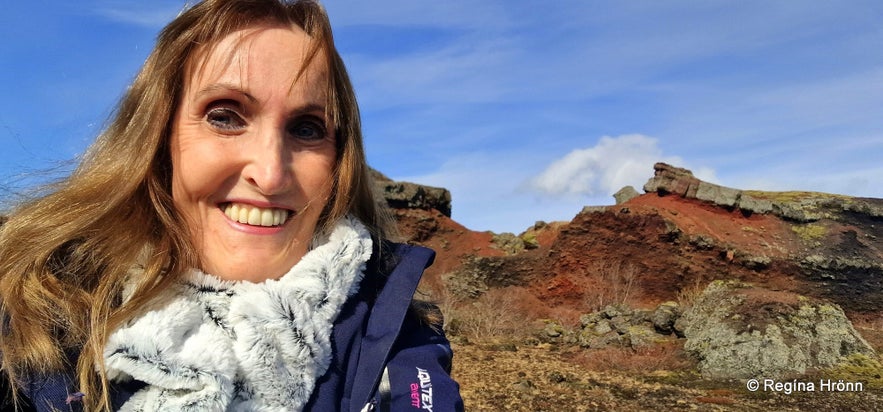 By Rauðhólar on a cold but sunny April day
By Rauðhólar on a cold but sunny April day
They are especially beautiful when the sun shines on them making the red vibrant colours very vivid.
There is something so magical about walking amongst these red pseudocraters and I can only compare them to the mystical Dimmuborgir in Mývatn, which were formed under similar circumstances with a different outcome though.
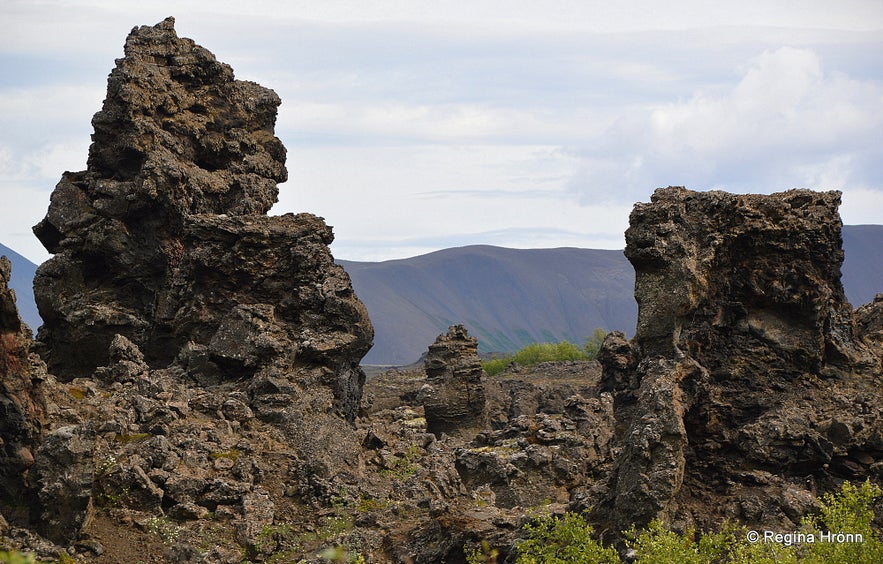
Dimmuborgir in North Iceland
Dimmuborgir is on a bigger scale than Rauðhólar, but nevertheless, in the right light, Rauðhólar will make you feel like you entered another planet.
The Rauðhólar protected area covers some 130.2 ha and earlier on there were around 80 pseudo craters here.
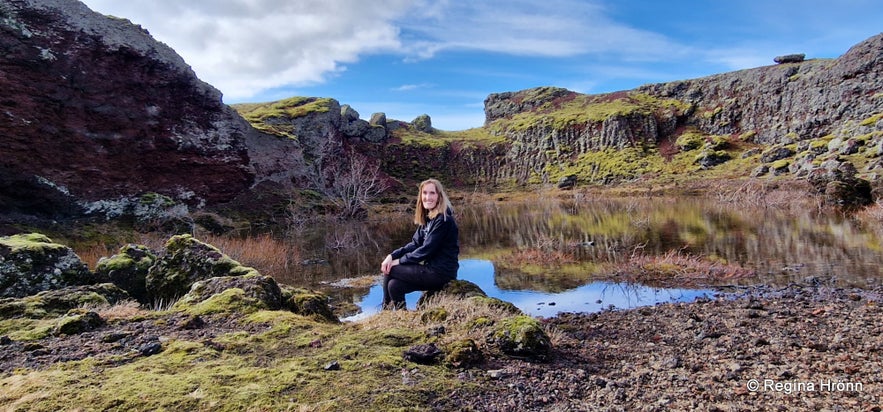 There is a beautiful pond at Rauðhólar
There is a beautiful pond at Rauðhólar
Material for different purposes was taken from Rauðhólar, such as filling material, some of which was used for the domestic airport, Reykjavíkurflugvöllur, during WWII, which was built by the British army.
The British documented how much material they used and it was only 95,000 cubic meters (ref. Rauðhólar, ekki Bretum um að kenna).
Some of the material from Rauðhólar was used for roads and fill material before and after the war.
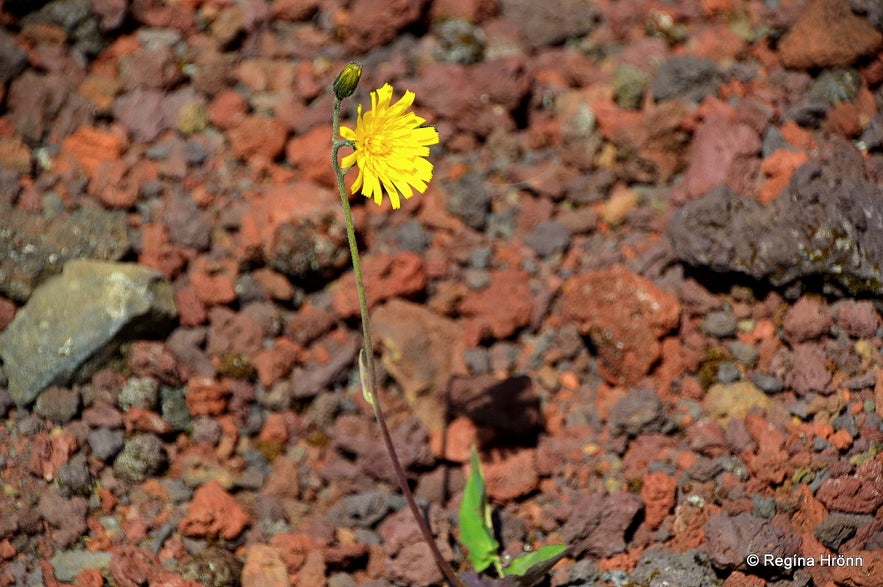
Life finds its way through the lava
It is such a pity that large parts of Rauðhólar were destroyed, they must have been quite magnificent before truckloads of red gravel were removed from them.
Rauðhólar were preserved back in 1961 and declared a nature reserve in 1974.
I have visited other craters in South-Iceland, Seyðishólar, which are bright red in colour and very exotic but are now used as a quarry. You can see parts of the craters in my photo below, but the quarry is closed to traffic.
Seyðishólar quarry in South Iceland
In North Iceland, in the magnificent Jökulsárgljúfur canyon another set of maroon craters is to be found.
In the summer of 2020, I spent several days hiking in Jökulsárgljúfur canyon and hiked from Hljóðaklettar Echo Rocks to Rauðhólar (a relatively short hike, compared to other hikes in the canyon).

Rauðhólar craters in Jökulsárgljúfur canyon
I had seen a photo of the maroon pillars in my photo below and really wanted to see them with my own eyes. Aren't they amazing, like some fairytale creatures?
I have written another travel-blog about the glacial river Jökulsá á Fjöllum which runs through Jökulsárgljúfur canyon:
Jökulsá á Fjöllum Glacial River and the Waterfalls in Jökulsárgljúfur Canyon
Horseback riding at Rauðhólar
During my recent visits to Rauðhólar in the south, I have encountered many people on horseback.
Horseback riding tours are popular here and the volcanic landscape at Rauðhólar is an ideal spot for this type of outdoor sport.
I posted a short video on YouTube of horses I met at Rauðhólar.
Here is a video I shot last winter of the Icelandic horses playing:
The last photo of Rauðhólar I took from a helicopter during a helicopter tour which I joined. The photo is a bit blurred as I took it through the glass of the helicopter window.
I was a bit unprepared as this was my first time in a helicopter and it took me some time to recognise the landscape of my own country from above ;)
In the photo, you can see how close Rauðhólar are to ring-road 1 and how easily accessible they are.
To visit these beautiful red pseudocraters you can rent a car in Reykjavík and take ring-road 1 going southeast out of Reykjavík and drive for 6-7 km out of the city.
Turn right on road 408 when you reach a sign for Heiðmörk and right again for the pseudocraters.
And if you will be driving further on along the south coast of Iceland then I would recommend a visit to the extraordinarily colourful Raufarhólshellir lava tube.
Also check out: The Unique Phenomenon Pseudocraters in Iceland
Tröllabörnin - the Troll Children
Tröllabörnin hornitos in SW-Iceland
In Lækjarbotnar some 5 km east of Rauðhólar pseudocraters you will find another preserved natural phenomenon, which is also right by ring-road 1.
Most people don't know about this spot, which we call Tröllabörn or the Troll Children.
The Troll Children, which were formed at the same time as Rauðhólar pseudocraters, are a cluster of hornitos - spatter cones - covering some 4.7 hectares of land and are well worth a visit.
The information sign by Tröllabörnin
The Troll Children were formed during a volcanic eruption when the hot steam from the lava flow tried to find its way through the ceiling of the forming lava tunnel.
When the steam managed to force itself through the forming lava ceiling and connected with the oxygen in the air, it burned at a really high temperature - and molten lava splashed up and solidified. Thus the steep spatter cones were formed.
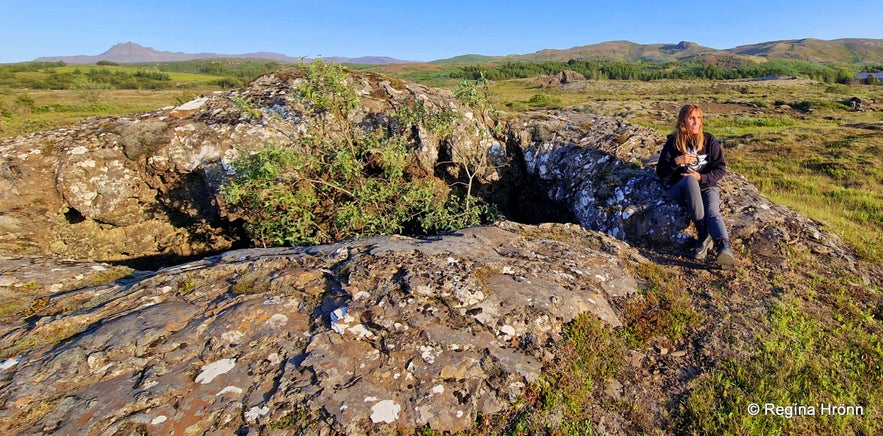 Tröllabörn and I
Tröllabörn and I
These cones actually show how the steam or gasses left the lava flow, which makes it a really interesting geological phenomenon.
You can see in the sign above how it happened - this sign is by the parking and was donated by the Kiwanis, Lions, and Rotary clubs.
Tröllabörnin hornitos in SW-Iceland
The volcanic eruption in this area took place some 5,000 years ago in the shield volcano Leiti and formed the Leitahraun lava field.
You will find some 10 Troll Children varying in size and shape in the reserved area, more in the surrounding areas.
Also, notice the different colours of the lava - this is an old lava field, but you can still see the different colours in the accumulated solidified lava in the hornitos.
Colourful lava at Tröllabörnin hornitos
These lava formations were preserved back in 1983. I have seen similar lava formations up north in Aðaldalur and written a travel-blog about them - the Peculiar Knútsstadaborg Lava Chamber in Aðaldalshraun in North Iceland.
Tröllabörn - the Troll Children are located right next to ring-road 1.
Here you can see the exact location of Tröllabörn on Google Maps.
With Jón contemplating on which turf house to buy
On your way from and to Reykjavík be on the lookout for the man in my photo above - his name is Jón Karlsson and he often sells beautiful handmade replicas of the traditional Icelandic turf-houses. He was usually stationed close to the first roundabout by ring-road 1 when leaving the city going southeast.
I spotted him last summer and wanted to buy a red turf house, but unfortunately, the red ones were all sold out. But, for my last birthday, my husband surprised me with a beautiful red turf house :) He went to Jón's home and made sure that he had a red turf house in stock. I am elated :)
My birthday present from my husband - a lovely red turf-house :)
Turf houses are a passion of mine, so I really need them in all colours; black like Þverá and Skógar turf houses, white like Grenjaðarstaður turf-house, and red like Bustarfell turf-house.
These replicas are very popular amongst Icelanders and you can see them in many gardens in Iceland. They are sometimes referred to as elf houses :)
Here is the location of Rauðhólar on Google Maps.
Autres blogs susceptibles de vous intéresser
Mystérieuse Islande
Je me suis longtemps demandé pourquoi j’aimais tant cette île rocheuse et mystérieuse, souvent sombre, tempétueuse... secrète ! C’est peut-être justement pour cette raison – un lieu unique ayant toEn savoir plusPlongée à la faille de Silfra
En octobre dernier, j'ai eu la chance de tester une session snorkeling à Silfra en Islande ! Cette expérience était magnifique ! Je pense que c'est mon activité préférée avec la visite d'une grottEn savoir plusCe qu’on ne vous dit pas avant un voyage en Islande
Vous partez en voyage en Islande ? Vous avez sûrement déjà épluché les forums, guides et autres sites de voyage, réservé votre vol et organisé votre circuit ? Parfait, parfait. Mais avant de savourerEn savoir plus

Téléchargez la plus grande plateforme de voyage d'Islande sur votre téléphone pour gérer l'intégralité de votre voyage au même endroit
Scannez ce code QR avec l'appareil photo de votre téléphone, et cliquez sur le lien apparaissant pour avoir la plus grande plateforme de voyage d'Islande à portée de main. Ajoutez votre numéro de téléphone ou votre adresse e-mail pour recevoir un SMS ou un e-mail avec le lien de téléchargement.
